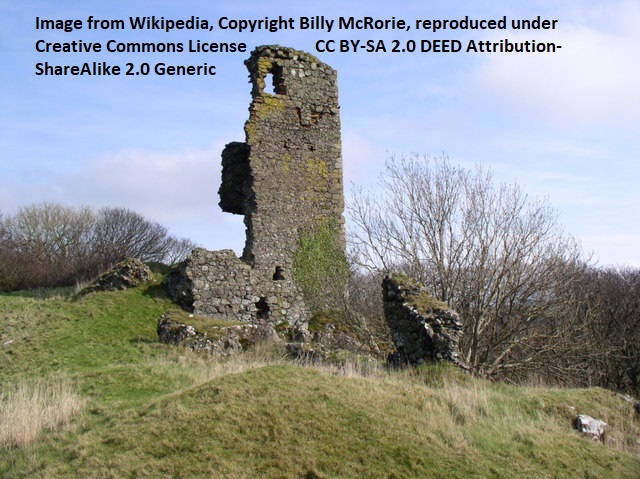Ardstinchar Castle

Ardstinchar Castle Details
Ardstinchar Castle, ruins of C16 tower and courtyard of the Kennedies, abandoned by Hamiltons C18 and used as a quarry
- Closest To: Ballantrae
- Access: S.O.A.C. Public Access
- Grid Reference: NX087824
Ardstinchar Castle is the ruin of a well-situated tower and courtyard protected by a ditch on a headland which overlooks what was probably a fording point of the River Stinchar in Ayrshire. It was mostly demolished in 1770 to erect the old Ballantrae Bridge that crosses the river just below the castle. fragments of the courtyard wall survive together with a large fragment of the tower-keep erected for the Kennedy family, supposedly in the 15th century, although the walls do not seem thick enough for this early date to me at only 1.1 metres, bearing in mind the courtyard wall is up to 1.6 metres thick. Ardstinchar was held by the Kennedies of Bargany from the mid 16th century, with documents dated there in 1557 – and the castle is mentioned in a document of 1604. However, a document dated in 1552 at “Ballantrae, at the rock thereof” – which is the site of the castle – would presumably have recorded a castle. It would seem probable that the castle was therefore built between 1557 and 1604, although it could have been a fortified manor prior to this date.
The last Kennedy of Ardstinchar was killed in 1601, his widow remaining in the castle, and after her death in 1605, the estate was sold to Sir John Hamilton of Letterick. Hamilton’s father had a charter of Bargany from 1624, so when he inherited his father’s estate in 1637 Ardstinchar was reunited with Bargany. By the mid 18th century the castle had been long abandoned (perhaps having been damaged during the wars of the mid 17th century – Hamilton was an active royalist) and was in a state of disrepair. Hamilton’s son, another John, assumed the title Lord Bargany in 1662, but was unable to secure a return of the £2000 fine his father had been forced to pay for the return of the family estates. He was vehemently opposed to the Puritan Covenanters, and was charged with treason by his neighbour, James Crawford of Ardmillan. This was proven in his favour, but perhaps by this time Ardstinchar was already beyond repair, especially since he had never recovered the £3,000 he had used to pay off his wife’s debts at their marriage!
Become a supporter of my work to access a more detailed history